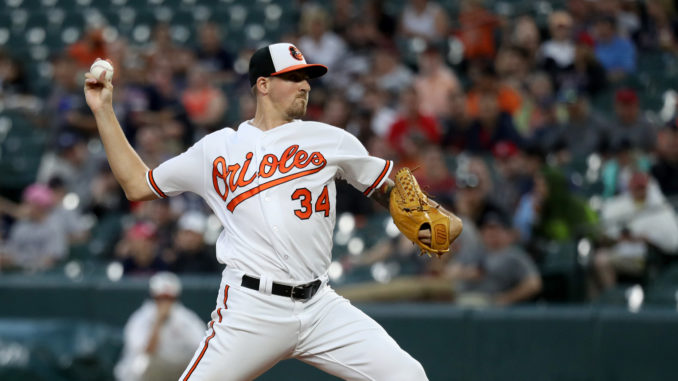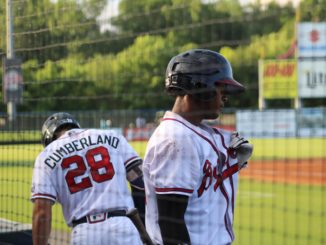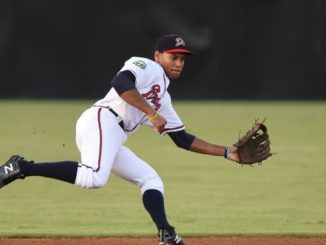
Atlanta trades Jean Carlos Encarnacion, Brett Cumberland, Evan Phillips, Bruce Zimmermann, and $2.5M in international bonus money to Baltimore for Kevin Gausman and Darren O’Day
Each year, the trading deadline gets distilled into a simple dichotomy of buyers and sellers. Is your local team going to make the playoffs? If so, they’re a buyer. If not, they’re a seller. However, it’s a little more complicated than that. There are different kinds of buyers and different kinds of sellers.
Take the 2016 Chicago Cubs, for example. On July 24 of that year, the Cubs beat the Brewers 6-5 as the 2nd place Cardinals lost 9-6 to the Dodgers. This gave the Cubs a 7.5 game cushion in the NL Central as well as the best record in baseball at 59-38. The 2016 Cubs, barring some kind of historic collapse, were going to the playoffs. Starved for an end to their legendary World Series drought, the team traded top prospect Gleyber Torres, along with three other players, for reliever Aroldis Chapman. It was an overpay in a vacuum, giving up 6 years of one of baseball’s best infield prospects for 2 months of Chapman. It made sense, however, because while Torres probably had much more regular season value than Chapman over the long haul, a dominant reliever can be of great importance in the playoffs. Chicago made a trade not intended to get the team to October, but to dominate once there.
The 2018 Braves aren’t in the same position. October isn’t a given, so Atlanta couldn’t simply make moves to help win playoff games. The Braves couldn’t justify pushing all its chips to the middle of the table for a 2018 playoff run. Instead, the team took steps to improve 2018’s playoff odds as much as possible while still keeping its eyes on future seasons, seasons where such an October run might be more certain. August dawns on a team that is still very much in the hunt; according to Fangraphs, the Braves are 30.5% likely to make the playoffs, which isn’t insignificant. And, thanks to the efforts of Alex Anthopoulos, it dawns on a better Braves team for both the present and the near-future.
Kevin Gausman
The former #4 overall draft pick out of LSU mostly relies on three pitches: a 94 mph four seam fastball (thrown 59% of the time), an 84 mph splitter (24%), and an 81 mph slider (16%). The splitter is the best of the three, which helps explain his reverse splits: the right-handed Gausman has always been more effective against lefty batters (.315 wOBA) than righties (.342), a trend that has continued in 2018 (.336 and .354, respectively). Against lefties, he’ll throw the pitch roughly a third of the time, and they can’t do anything with it, batting .191 against the pitch in 2018.
Against righties, Gausman will use the slider as his #2, and it’s functional when he gets the chance to set it up and use it. Those chances don’t come often enough, though, as Gausman’s biggest issue with his arsenal is his most important pitch, the one I have put off discussing: that four-seamer. Hitters are clobbering his fastball this year. Lefties are batting .294 against it with a wOBA of .378. Righties are hitting .364 off it with a wOBA of .413. This wasn’t the case when Gausman was a younger hurler and threw much harder, but as he, like most pitchers do, gave up some velocity in hopes of better command, the fastball just got less and less effective. When he can set up his secondary offerings, they’re good against righties as well, but setting them up with the fastball has been the issue. Still, here’s what Gausman looks like when he’s able to set up his slider and splitter:

Here’s what the fastball looks like when it’s working:
Alex Anthopoulos probably thinks the Braves can fix this issue, and Gausman may agree. The GM spoke of helping Gausman “unlock” his potential, and Gausman himself mentioned how the team might help him. I have to imagine they’re talking about the fastball. Gausman is clearly aware of its diminished effectiveness: he’s throwing it less frequently than ever in his career. If pitching coach Chuck Hernandez can work with Gausman on adjustments here and there, small improvements will do wonders for his pitching repertoire.
Gausman isn’t simply a reclamation project, though. He’s instantly useful, a workhorse who led the AL in starts in 2017 (34). He sports a 19.5 K% and 6.0 BB% and an xFIP of 4.05. Since the beginning of 2016, Fangraphs credits him with 6.8 WAR. He’ll reliably slot into a rotation that needs some reliability. While he certainly has the potential to be a late-blooming ace, similar to Jake Arrieta after also escaping the pitcher development hell that is Baltimore, he is more realistically a #3 or #4 starter for this team going forward, behind Mike Foltynewicz, Sean Newcomb, and depending on which side of the bed he awoke that morning, Julio Teheran.
As with all acquisitions, it’s important to know not just what type of player the team picked up, but how much of him. Gausman, signed for 2018 at $5,600,000. He’ll earn an extra $50,000 each when and if he makes his 4th, 9th, and 12th starts with the Braves. Beyond 2018, Gausman is under team control for two more arbitration-eligible seasons, reaching free agency after the conclusion of the 2020 season. This is a significant reason Gausman appealed to Atlanta. He isn’t a mere rental, but rather part of the plan going forward.
Darren O’Day
O’Day is injured and will miss the rest of 2018 while recovering from hamstring surgery. If he returns in 2019, where he’s signed for $9,000,000 {Editor Note: O’Day’s salary for 2019 is $8M. He has $1M each year of his contract deferred to 2020-2023. – CJ, with info from Braves Options Guy}, at full strength, the Braves will have one of the better right-handed relievers in the league.
Prior to his injury, O’Day was striking out a whopping 32.5% of batters and walking only 4.8%. The sidearm righty is unusual for his type. He doesn’t particularly excel at getting ground balls, but he does induce whiffs at a high rate. Here’s a sneak peek for what you’ll hopefully see next year:

And once he’s able to move pretty well, expect him to take on another role – catching home runs in the bullpen. Seriously, it’s kind of his thing:



Notice how he always wears his glove? He learned the hard way:

O’Day is probably a salary dump of sorts for the Orioles, but don’t mistake it for a salary dump in the sense of other recent Braves acquisitions like Carlos Quentin, Bronson Arroyo, and Adrian Gonzalez. Darren O’Day is penciled into the 2019 bullpen plans, and if he’s healthy, he should be a key part of the team’s push for the NL East.
What We Lost
The headliner of the deal was catching prospect Brett Cumberland, who OFR’s Andy Harris ranked #13 in the system a few weeks ago. Here is Andy’s most recent write-up on Cumberland, and Baltimore will get a bat-first prospect who may or may not ultimately be a catcher. Given Atlanta’s wealth of catching prospects, I don’t think Cumberland will be meaningfully missed, but he was a player with a big league future you could talk yourself into.
Bruce Zimmermann, ranked 19th in the system here at OFR, is in the midst of a head-turning season. The Braves sold high on him, which is something smart teams do, but that doesn’t mean he’ll be a disappointment. I could see a role as a lefty reliever in his future. It’s hard not to be happy for Zimmermann, who now goes to the organization he grew up rooting for.
Jean Carlos Encarnacion is everyone’s favorite prospect, provided he’s outside your top 10. He’s high on upside with an ocean of potential variance in his outcomes. That’s fun to dream on, as long as you don’t have to rely on it. The Braves didn’t have to rely on it (he placed 20th in our recent rankings), so it was always fun to keep an eye on JCE’s progress. He’ll be more meaningful for the Orioles, so if his discipline-be-damned ways continue to keep his violent swing on a leash, O’s fans won’t be able to shrug it off quite as easily. Still, that organization needs an injection of talent, and JCE is that.
Evan Phillips made his MLB debut earlier this year for the Braves, and here’s one last look at Phillips. Phillips should find more playing time in Baltimore’s bullpen, where he has a chance to become useful.
As for the money, you’re by now aware of Atlanta’s spending limitations in the international market (thanks, Coppy!). So, the team made the best use of the money it was still allotted and traded it for a something they were permitteed to have (thanks, Thoppy!).
Final Thoughts (finally!)
It’s hard not to like this trade. While Atlanta’s prospect depth won’t be what it has been, the organization loses nothing of real significance here. There’s nothing that’s likely to be irreplaceable. The biggest potential impact loss would be Encarnacion, but while he certainly could put it all together, most players like him simply don’t.
Even if he is unable to turn his fastball into a consistent weapon, Gausman gives the team a durable starter who should be helpful in an inning-eating capacity over the next 26 months. And if he worsens, he could be a prime candidate for a bullpen makeover, a move that would allow his fastball to be unleashed a bit. But those are worse-case scenarios; the Braves believe Gausman can and will be a key rotational piece going forward, and if they’re correct, they got him for a pittance. Add O’Day to the mix, and you can see how the team improved both its present and future at a relatively low cost. That makes this the right move for this team, this year.




Leave a Reply